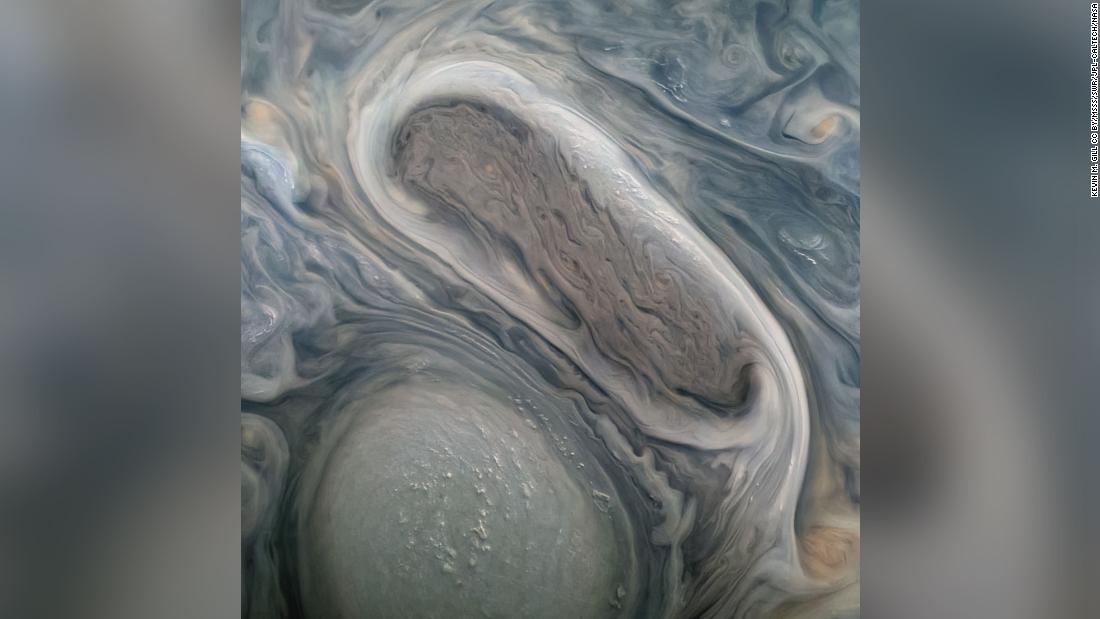(CNN) – The largest planet in our solar system seems to be more and more a work of art. Like its moons it is full of surprises. The Mission NASA’s Juno, which began orbiting Jupiter in July 2016, recently approached its 38th gas giant. The mission was extended earlier this year, adding a flight to Jupiter’s moon Canyme in June.
Scott Bolton, Juno’s chief analyst, said the data and images of these flybrays rewrite everything we know about Jupiter. Southwest Research Institute In San Antonio, during a conference on the fall of the American Geophysical Union in New Orleans this Friday.
There, Bolton revealed the 50-second sound made during the summer when Juno crossed the canyon. The audio clip of the moon was generated by the electric and magnetic radio waves generated by the planet’s magnetic field and taken by the waves instrument of the spacecraft designed to detect these waves.
The sounds are like a captivating space age soundtrack.
“This soundtrack is enough to make you feel like you’re riding Juno with Canyme for the first time in more than two decades,” Bolton said. “If you listen carefully, you can hear the sudden change to higher frequencies around the middle of the record, which marks the entrance of another part of the magnetosphere of the canyon.”
Juno’s team continues to analyze data from the Canyme fly. At the time, Juno was about 645 miles (1,038 kilometers) from the Moon’s surface, with a speed of 41,600 miles (67,000 kilometers).
“The change in frequency shortly after the close approach may be due to the transition from the night side of the canyon to the day side,” said William Kurt, co-principal researcher at the University-based Waves tool. California. Iowa, in a statement.
The group also shared stunning new images similar to the art scenes of Jupiter’s rotating atmosphere.
“You can see how incredibly beautiful Jupiter is,” Bolton said. “It’s really an artist’s palette. It’s almost like a Van Gogh painting. You see these incredible spirals and clouds spinning in different colors.”
These fascinating images help scientists to better understand Jupiter and its mysteries. Images of hurricanes at Jupiter’s poles impressed scientist Leah Siegelman, who works with Juno’s team and explores Earth’s oceans in general. He found similarities between Jupiter’s atmospheric dynamics and the vortices in the Earth’s oceans.
“When I looked at the richness of the turbulence around Jovian hurricanes, with all the small strands and spirals, it reminded me of the turbulence you see in the ocean around the spirals,” said Seagalman, a physics oceanographer and postgraduate teacher at Scripps. At the University of California, San Diego, in a statement.
“These are particularly evident in the high-resolution satellite imagery of the vortices in the Earth’s oceans, which are expressed by the flowers of Plankton, which act as flow tracers.”
Maping the magnetic field of Jupiter
Oceanographers use their expertise in oceanic cycles to study the turbulence at Jupiter’s poles and the physical forces that drive its major hurricanes. Compare the picture of the phytoplankton blooming with the turbulent clouds in the atmosphere of Jupiter (left) in the Norwegian Sea (left).
Juno data enable scientists to map Jupiter’s magnetic field, including the Great Blue Spot. This region is a magnetic anomaly located at the equator of Jupiter, which should not be confused with the large red dot as a centuries-old atmospheric storm south of the equator.
Since Juno landed on Jupiter, the team has seen a change in Jupiter’s magnetic field. The Great Blue Spot moves about 2 inches (5.1 cm) eastward per second and will complete a revolution around the planet in 350 years.
Meanwhile, the Great Red Spot is moving west and will cross that finish line very fast in about 4.5 years.
But the Great Blue Spot is cut off by Jet Streams on Thursday, giving it a striped look. This visual method tells scientists that the air in this planet spreads very deep inside the planet.
Map of Jupiter’s magnetic field generated by Juno data. Also revealed that the metal under the “helium” layer is formed from hydrogen.
Juno was able to observe a faint ring of dust around Jupiter from inside the ring. This dust was actually created by two small moons on the planet, called Medis and Atrastia. These observations allowed researchers to view parts of the Perseus galaxy from another planetary perspective.
Heidi Becker, co-principal analyst at NASA’s Jet Propulsion Laboratory at Jas Propulsion Laboratory in Pasadena, California, said: “It’s interesting that we can see these familiar galaxies from a spacecraft half a billion miles away.
“But all of this sounds like we’re admiring them from our backyards on earth. It’s a threatening reminder of how small we are and how much more we need to explore.”
In the fall of 2022, Jupiter’s moon will be flown by Europa, which will be viewed by its own mission Europa Clipper, which will launch in 2024. Europa is manipulating scientists because a global ocean lies beneath its ice. From time to time, feathers emerge from holes in the ice into space. Europa Clipper can “test” this ocean and study it by flying through its feathers to see if life is possible in this ocean world.


:quality(85)/cloudfront-us-east-1.images.arcpublishing.com/infobae/SMPW7M5BQFERBOQUPJXKCOKARY.jpg)
:quality(85)/cloudfront-us-east-1.images.arcpublishing.com/infobae/NP5NEZXMZFGNLBHNEQJHPJVMKM.jpg)

:quality(85)/cloudfront-us-east-1.images.arcpublishing.com/infobae/X7DZAL3I4REJTKPZ4Y4DYBHFMI.jpg)